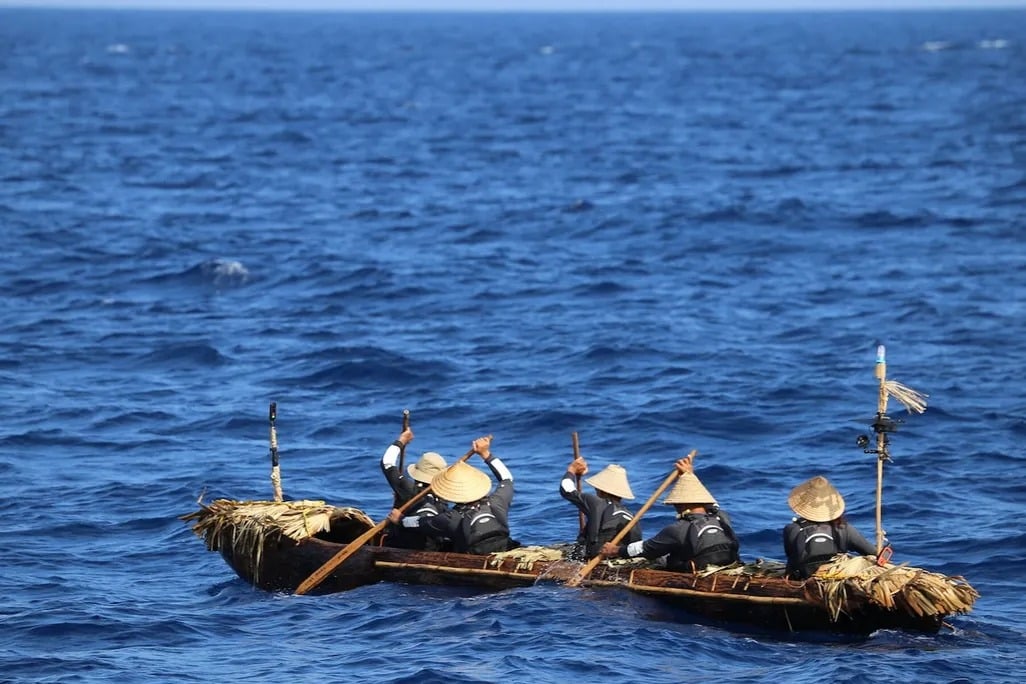Japanese Scientists Recreate Early Human Voyage
Language
Reading Level
Listen to Article
Alignment

While working at an archaeological site on Okinawa Island in Japan, Professor Yousuke Kaifu from the University of Tokyo pondered over some ancient tools. Dating back 30,000 years, they hinted at human arrivals from both the north and south.
"How did Paleolithic people arrive at such remote islands as Okinawa? How difficult was their journey? And what tools and strategies did they use?" Dr. Kaifu wondered.
To find out, Dr. Kaifu came up with a bold idea. He and his team would attempt a sea voyage like the one ancient humans may have taken. They chose to travel from Taiwan to Japan’s Yonaguni Island — a distance of about 140 miles (225 km). Though closer to Taiwan than to Okinawa, Yonaguni sits across the Kuroshio Current, one of the strongest ocean currents in the world. That made the journey even more difficult.

The team's first challenge was building a boat that ancient humans might have used. The researchers initially assumed that they might have traveled on bamboo and reed rafts. However, the rafts were too slow and not sturdy enough to survive the Kuroshio.
The mariners eventually settled on a dugout canoe similar to ones used by humans about 10,000 years ago. They used hand saws to chop down a massive Japanese cedar tree and shaped it using replicas of 30,000-year-old stone tools. The result was a sturdy, 24-foot (7 m) canoe named Sugime, the Japanese word for cedar. The scientists then studied water currents and seasonal patterns to determine the best time to make the journey.
Finally, on July 7, 2019, five sailors — a mix of scientists and professional paddlers — set off to Yonaguni Island aboard the Sugime. Just like the ancient sailors, they relied on the sun, wind, stars, and ocean currents to guide them.

The journey was not for the faint-hearted. Rough, choppy waves crashed against the canoe, filling the boat with water. The team had to use buckets to bail it out. At night, thick clouds hid the stars they had planned to use for navigation. Instead, the sailors turned to another ancient method — reading the ocean swells. The rhythm and direction of the waves helped them stay on course, just like the early seafarers. After 45 long hours, the exhausted paddlers finally spotted Yonaguni Island. They had done it!
Kaifu and his team published their findings in the journal Science Advances on June 25, 2025. They also released a 90-minute documentary about their experience.
"Paleolithic people are often regarded as 'inferior' among the general public, primarily due to their 'primitive' culture and technology," the team stated. "In sharp contrast, our experiment highlighted that they accomplished something extraordinary with the rudimentary technology available to them at the time."
Resources: Smithsonianmag.com, Popsci.com, Americanscientist.com

Get the Workbook for this article!
Workbook contains: Article, Reading Comprehension, Critical Thinking Questions, Vocabulary in Context (+ answers), Multiple Choice Quiz (+ answers), Parts of Speech Quiz (+ answers), Vocabulary Game (+ answers)Cite Article
Learn Keywords in this Article
8 Comments
- cutsiediva001about 1 monthIf I were the person in the front I would be screaming and crying ngl...
- bagutojitedaabout 1 monthSo yeah this is preety cool :D
- bagutojitedaabout 1 monthThis article is pretty cool. It explains how, while studying ancient tools on Okinawa Island, Professor Yousuke Kaifu wondered how early humans managed to reach such remote places 30,000 years ago. To explore this, he and his team recreated a possible Paleolithic sea voyage by paddling a handmade dugout canoe from Taiwan to Japan’s Yonaguni Island — a tough 140-mile journey across the powerful Kuroshio Current. They crafted the canoe using replicas of ancient stone tools and carefully planned their route using natural elements like ocean currents and seasonal patterns. The trip took 45 grueling hours, with the team battling waves, bailing water, and navigating by reading ocean swells when stars were hidden. Their successful voyage, published in Science Advances, challenges the idea that early humans were primitive, showing they were capable of impressive feats with simple tools and deep knowledge of nature.
- cookiechan2 monthsThey are very brave!
- bobby_boy2 monthsI just love this story because its just so cool and inspireig and they are just so brave to be doing this
- ueeaueea2 monthsLooks soo hard
- newsmp2 monthsThey are so brave to do this!
- 852128sophie2 monthsYeah, it seems so risky to ride a small canoe like that across the waters!